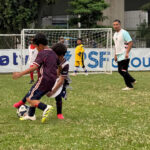
Leveraging Indonesian diaspora athletes has gradually proven effective in enhancing the country’s performance in sports. For instance, these athletes have played a pivotal role in the success of Indonesia’s national football team, aiding their qualification for the 2027 Asian Cup and the Third Round of the 2026 World Cup Qualifiers. The pressing question now is, how can we extend the utilization of the Indonesian diaspora beyond sports to other vital sectors such as science, technology, engineering, and mathematics (STEM)?
This question is crucial in our efforts to realize the Vision of Golden Indonesia 2045, which necessitates superior human resources, and in the context of the global talent war, where every nation strives to attract the best talent to live and work within its borders. Before discussing the steps to harness the Indonesian diaspora, we need to understand who the Indonesian diaspora are.
Defining the Diaspora
According to Presidential Regulation No. 76 of 2017 and the Indonesian Diaspora Congress, the Indonesian diaspora comprises Indonesians living abroad. This includes Indonesian citizens, former Indonesian citizens, and descendants of Indonesian citizens and/or former Indonesian citizens. The Indonesian diaspora is spread across more than 90 countries worldwide.
World Bank data indicates that the Indonesian diaspora numbers around nine million people—equivalent to the population of South Sulawesi, the seventh-largest province in Indonesia. Data from the Ministry of Foreign Affairs and BP2MI shows that at least 3 to 4.6 million people hold Indonesian citizenship, while the rest have foreign citizenship or limited dual citizenship until the age of 21.
Like a microcosm of Indonesia, the Indonesian diaspora engages in various professions. Some are lecturers, scientists, and/or involved in STEM fields.
Steps for Optimization
In their vision and mission, President-elect Prabowo Subianto and Vice President-elect Gibran Rakabuming Raka emphasize the importance of utilizing “the potential of the Indonesian diaspora to achieve national interests.” They have repeatedly committed to increasing the number of workers in STEM fields and other highly skilled professions. Here lies the convergence. For instance, these diaspora members can support several downstream programs that the next government will continue and amplify.
Referring to the book “Developing a Road Map for Engaging Diasporas in Development” and studies from the Migration Policy Institute, there are at least four steps to be taken in utilizing the diaspora for development. The first step is to conduct a comprehensive and accurate census of the Indonesian diaspora. This database is crucial for mapping the talents of the Indonesian diaspora based on their expertise, industry, location, and willingness to contribute to national development.
In several countries like the Philippines and Bosnia, the government can easily search for their diaspora based on skills, educational background, and industry. Creating a diaspora database is not difficult. For example, at the Ministry of Youth and Sports, more than 600 Indonesian diaspora athletes active in over 10 sports have already been registered. The same can certainly be done for other skilled Indonesian diaspora members.
The second step is to communicate and collaborate with government bodies, the private sector, and industry leaders to identify talent needs that can be filled by the Indonesian diaspora. In other words, we need to understand the needs at home and how much of these needs can be met by the diaspora. For example, in the technology sector, we need 1,000 experts in artificial intelligence and cybersecurity. We then map out approximately what percentage can be supplied by the Indonesian diaspora.
The third step is to offer attractive incentives for the diaspora to contribute or return to Indonesia. These can include tax incentives, ease of repatriation processes, access to professional networks, and attractive career opportunities in strategic sectors. Often, what Indonesian diaspora members seek is the opportunity to apply their knowledge to something that will have a significant impact—not just financial rewards.
The fourth step is to communicate with these skilled Indonesian diaspora members and explain the potential opportunities available, ranging from research collaborations and fellowships to jobs in strategic sectors. This communication also aims to explain the incentives and opportunities available at home. If these diaspora members choose to continue their careers in Indonesia permanently, this is called reverse brain drain. If not permanently, at least it results in brain circulation, which is beneficial in creating a flow of knowledge, technology, and skills.
Essentially, the government does not need to form a new agency or institution to manage this. A small team capable of diplomacy and agile movement can reach out to talented diaspora members and interact with stakeholders in Indonesia who need such talents. This concept is similar to matchmaking and headhunting but aimed at national interests.
With these steps, we can optimize the potential of the diaspora not only in sports but also in other vital sectors. Thus, the Indonesian diaspora can become a valuable asset that significantly contributes to national development, particularly in realizing the Vision of Golden Indonesia 2045.
Hamdan Hamedan
Executive Director of the Indonesian Diaspora Network-United (2017-2018)
*This writing is taken and translated from Optimasi Potensi Diaspora Indonesia.








